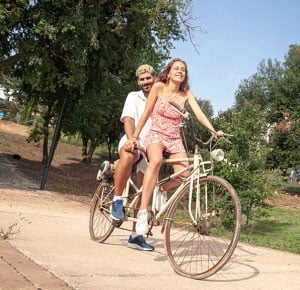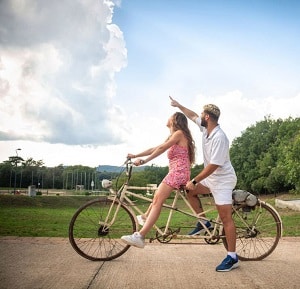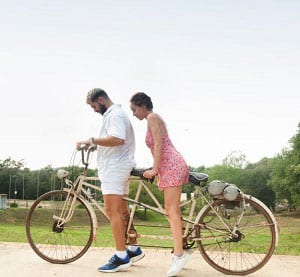Tandem bikes offer a unique cycling experience and an excellent activity for building better relationships with people. But while tandem biking has a low accessibility barrier, it is still important to know how to ride a tandem bike before diving in due to its differences from standard cycling.
We’ll take a look at how these two seater bikes are used in detail. Communication is an essential aspect of this activity, and we’ll have a look at some of the most important points there as well.
Keep reading to learn more.
Table of Contents
Guide on Riding a Tandem Bike
Step 1: Mount the bike
Getting on a bicycle is a bit different depending on your role, but riders mount the bike from the same side. Begin by securing the bike before getting on. The stoker or rear rider must hold on to the seat and the handlebar.
For the captain or front rider, it would be difficult to mount normally due to the two person bike having a rear handlebar. The proper way involves stepping the non-drive-side foot over the horizontal bar to mount and pressing the brakes to prevent the bike from moving.
However, the rider at the rear does not need to worry about their foot getting caught anywhere. This means that the stoker can get on the normal way.
While you may often see tandem bike riders get on the seats at the same time, it is recommended for tandem cyclists with beginners to take turns mounting the bike.
The captain goes first and supports the bicycle while the stoker gets on next. This ensures that someone is supporting the bicycle while the other is mounting it.
Step 2: Push off
Getting the bicycle moving is one of the trickier things to do when you’re just getting started. It’s easy to get a shaky start if the riders are not properly coordinated. This is where it is important to work together.
Proceed with the captain supporting the bicycle with one foot while the stoker has their feet on the pedals. Apply the brakes to prevent any accidental start. It is important for the captain to signal intent and for the stoker to acknowledge readiness.
Both riders should apply pressure on the pedals before releasing the brake to push the bike forward and then bring the kicking foot in.
Step 3: Bike operation and effective communication
Communication is an important part of a tandem ride meaning you won’t be able to do well without it. The captain communicates what changes need to be made, and the stoker needs to match the necessary adjustments.
The stoker is usually not in a position to see what is ahead, so it falls to the captain to ensure that the riding situation is properly communicated.
Every action while riding needs to be agreed upon, including gearing, speed, and turns. This can be verbal or by gestures. It is also important to remember that adjustments such as gear changes are made more frequently compared to standard bicycles, so constant communication is encouraged.
Low gears are best for climbing uphill, while a high gear is ideal for moving downhill. Medium gear should be used when starting the bike ride.
Even changes in the surroundings or road conditions need to be anticipated and communicated, including road elevation. Failure to do so may result in mismatching actions that may put the bike at risk.
Step 4: Get to a halt
Stopping a tandem bicycle requires the captain to anticipate the need for it earlier. This is because multiple rider bikes are longer and heavier, resulting in having more momentum that makes them harder to stop. It’s also useful to communicate the need to stop earlier.
Stopping begins with slowing down by easing on the pedal. As the bicycle starts to slow down, the captain shifts the gears down one at a time until reaching a low enough gear. The brakes are also engaged gradually.
The stoker has their own responsibility as well. They are tasked with using hand signals to communicate that the bicycle will come to a halt. This is done with a motion where the arm is stuck out to the side while the forearm is bent toward the ground, making a right angle with an open palm.
The captain should support the bike with the right foot once it has stopped.
Step 5: Dismount
The captain stops the bike and plants both feet on the ground to support the vehicle. He or she also needs to engage the brakes to fully secure the bicycle in place and prevent unwanted movement. Once ready, communicate to the stoker that dismounting can begin.
The captain should also specify which side to dismount to, but the usual choice is the right side. Once the stoker has dismounted, the captain also gets off on the same side.
Frequently Asked Questions
What is a tandem bike and how are they different from regular bicycles?
This is a 2 rider bicycle that is operated by multiple sets of pedals. Riders are lined up on such cycles, which can have up to 6 people, although more users also make it more difficult to properly synchronize.
Because these cycles have two sets of pedals, it’s also logical to wonder “are tandem bikes faster”? They are faster than regular bikes, although it may be more difficult to turn them well.
Is it difficult to ride tandem bikes?
They are not more difficult to ride compared to regular cycles, but it is more difficult to be the captain compared to being the stoker. The stoker only needs to properly support the captain, but a good leader can make it much easier.
Can you ride a tandem bike if you can’t ride a bike?
You can, but only as a stoker. Being a captain involves the same skills required when riding a standard bicycle, but many of those are not needed when riding at the back. Even children can ride this way if guided by someone dependable and experienced.
Who should ride in front on a tandem bike?
Who goes in front is decided by a person’s role, and the captain has more responsibility, since this means being in charge of controlling the bike as well as giving out signals. Due to the weight that comes with being captain, it is usually the more skilled and experienced rider that takes this position.
Can I ride a tandem bike alone?
It is possible but also difficult to do. Tandem bikes are designed for use by multiple people, and the extra length makes them very unwieldy. There’s also the matter of needing more pedaling power, since it is a heavier bicycle.
There’s a device called a stoker kit that can be installed, which makes riding alone manageable. However, it is still difficult to transport tandem bike by yourself due to their length and weight.
Are tandem bikes dangerous?
Like any other bike, tandems can be dangerous if you don’t use them properly. Compared to other bike types, they are not more dangerous and may even be safer to use, depending on the situation.
Since these are ridden by two people, you always have someone with you, so it is easier to deal with problems such as in case of an accident. Having two sets of eyes also allows tandem riders to spot hazards more effectively.
Conclusion
Now you know how to ride a tandem bike and how important communication is to this activity. Whether you’re just trying it out with a rental cycle or you’re interested in events such as tandem cycling Paralympics, take time to learn the important steps to keep safe while having fun.
What was your impression after seeing what a tandem bike look like? What do you think is the most challenging aspect of riding this type of bicycle? Tell us your thoughts in the comments section below.
Always ride safely.

“I ride my bike to work for years, but is that enough? Our carelessness towards our surroundings has taken a toll on the environment. And now, everyone is responsible for changes; even the most minor contribution is counted. With this hope and spirit, I started with my partner to establish Biketoworkday to help more individuals commute to their work sites on their bikes.”







